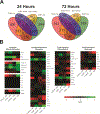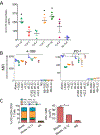TLR Stimulation during T-cell Activation Lowers PD-1 Expression on CD8+ T Cells
- PMID: 30201735
- PMCID: PMC6215515
- DOI: 10.1158/2326-6066.CIR-18-0243
TLR Stimulation during T-cell Activation Lowers PD-1 Expression on CD8+ T Cells
Abstract
Expression of T-cell checkpoint receptors can compromise antitumor immunity. Blockade of these receptors, notably PD-1 and LAG-3, which become expressed during T-cell activation with vaccination, can improve antitumor immunity. We evaluated whether T-cell checkpoint expression could be separated from T-cell activation in the context of innate immune stimulation with TLR agonists. We found that ligands for TLR1/2, TLR7, and TLR9 led to a decrease in expression of PD-1 on antigen-activated CD8+ T cells. These effects were mediated by IL12 released by professional antigen-presenting cells. In two separate tumor models, treatment with antitumor vaccines combined with TLR1/2 or TLR7 ligands induced antigen-specific CD8+ T cells with lower PD-1 expression and improved antitumor immunity. These findings highlight the role of innate immune activation during effector T-cell development and suggest that at least one mechanism by which specific TLR agonists can be strategically used as vaccine adjuvants is by modulating the expression of PD-1 during CD8+ T-cell activation. Cancer Immunol Res; 6(11); 1364-74. ©2018 AACR.
©2018 American Association for Cancer Research.
Conflict of interest statement
Figures







Similar articles
-
Toll-like receptor agonist combinations augment mouse T-cell anti-tumor immunity via IL-12- and interferon ß-mediated suppression of immune checkpoint receptor expression.Oncoimmunology. 2022 Mar 21;11(1):2054758. doi: 10.1080/2162402X.2022.2054758. eCollection 2022. Oncoimmunology. 2022. PMID: 35340661 Free PMC article.
-
TLR1/2 ligand-stimulated mouse liver endothelial cells secrete IL-12 and trigger CD8+ T cell immunity in vitro.J Immunol. 2013 Dec 15;191(12):6178-90. doi: 10.4049/jimmunol.1301262. Epub 2013 Nov 13. J Immunol. 2013. PMID: 24227786
-
Activation of NKT Cells in an Anti-PD-1-Resistant Tumor Model Enhances Antitumor Immunity by Reinvigorating Exhausted CD8 T Cells.Cancer Res. 2018 Sep 15;78(18):5315-5326. doi: 10.1158/0008-5472.CAN-18-0734. Epub 2018 Jul 16. Cancer Res. 2018. PMID: 30012672
-
A combined carrier-adjuvant system of peptide nanofibers and toll-like receptor agonists potentiates robust CD8+ T cell responses.Vaccine. 2018 Jan 25;36(4):438-441. doi: 10.1016/j.vaccine.2017.12.017. Epub 2017 Dec 14. Vaccine. 2018. PMID: 29248267 Free PMC article.
-
Dual blockade of PD-1 and CTLA-4 combined with tumor vaccine effectively restores T-cell rejection function in tumors.Cancer Res. 2013 Jun 15;73(12):3591-603. doi: 10.1158/0008-5472.CAN-12-4100. Epub 2013 Apr 30. Cancer Res. 2013. PMID: 23633484 Free PMC article.
Cited by
-
Influence of Donor-Specific Characteristics on Cytokine Responses in H3N2 Influenza A Virus Infection: New Insights from an Ex Vivo Model.Int J Mol Sci. 2024 Oct 11;25(20):10941. doi: 10.3390/ijms252010941. Int J Mol Sci. 2024. PMID: 39456722 Free PMC article.
-
Intratumoral delivery of TransCon™ TLR7/8 Agonist promotes sustained anti-tumor activity and local immune cell activation while minimizing systemic cytokine induction.Cancer Cell Int. 2022 Sep 19;22(1):286. doi: 10.1186/s12935-022-02708-6. Cancer Cell Int. 2022. PMID: 36123697 Free PMC article.
-
Multifunctional Nanodrug Mediates Synergistic Photodynamic Therapy and MDSCs-Targeting Immunotherapy of Colon Cancer.Adv Sci (Weinh). 2021 Jul;8(14):e2100712. doi: 10.1002/advs.202100712. Epub 2021 May 21. Adv Sci (Weinh). 2021. PMID: 34021727 Free PMC article.
-
Enhancing CAR T-Cell Function with Domains of Innate Immunity Sensors.Int J Mol Sci. 2025 Feb 5;26(3):1339. doi: 10.3390/ijms26031339. Int J Mol Sci. 2025. PMID: 39941106 Free PMC article. Review.
-
Prostate cancer research: The next generation; report from the 2019 Coffey-Holden Prostate Cancer Academy Meeting.Prostate. 2020 Feb;80(2):113-132. doi: 10.1002/pros.23934. Epub 2019 Dec 11. Prostate. 2020. PMID: 31825540 Free PMC article. Review.
References
-
- Day CL, Kaufmann DE, Kiepiela P, Brown JA, Moodley ES, Reddy S, et al. PD-1 expression on HIV-specific T cells is associated with T-cell exhaustion and disease progression. Nature 2006;443:350–4. - PubMed
-
- Tian X, Zhang A, Qiu C, Wang W, Yang Y, Qiu C, et al. The upregulation of LAG-3 on T cells defines a subpopulation with functional exhaustion and correlates with disease progression in HIV-infected subjects. J Immunol 2015;194:3873–82. - PubMed
Publication types
MeSH terms
Substances
Grants and funding
LinkOut - more resources
Full Text Sources
Other Literature Sources
Molecular Biology Databases
Research Materials

